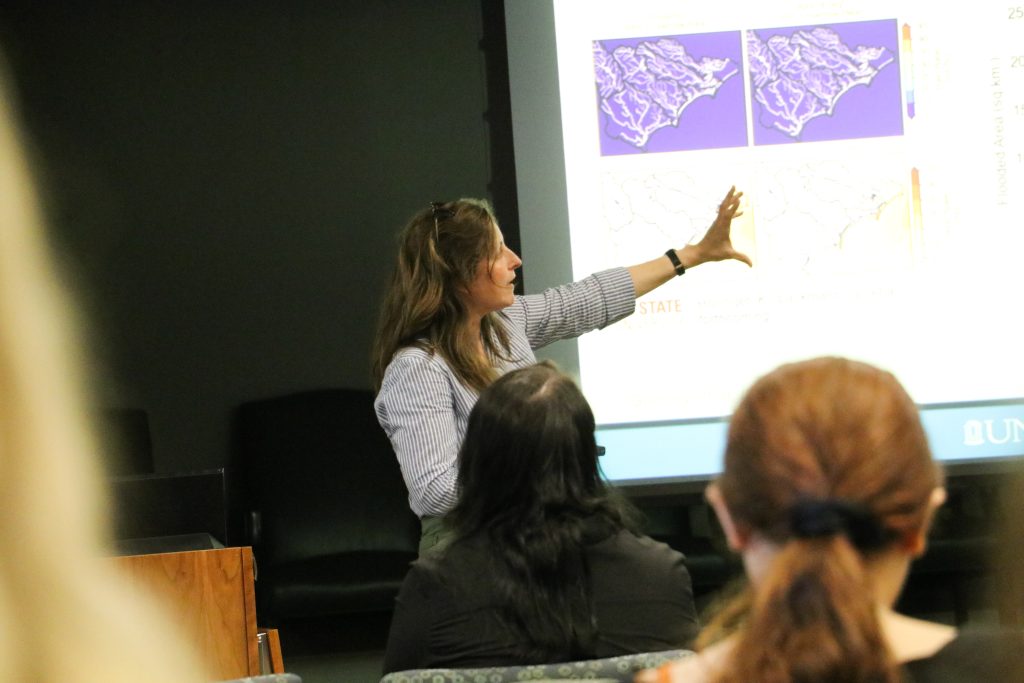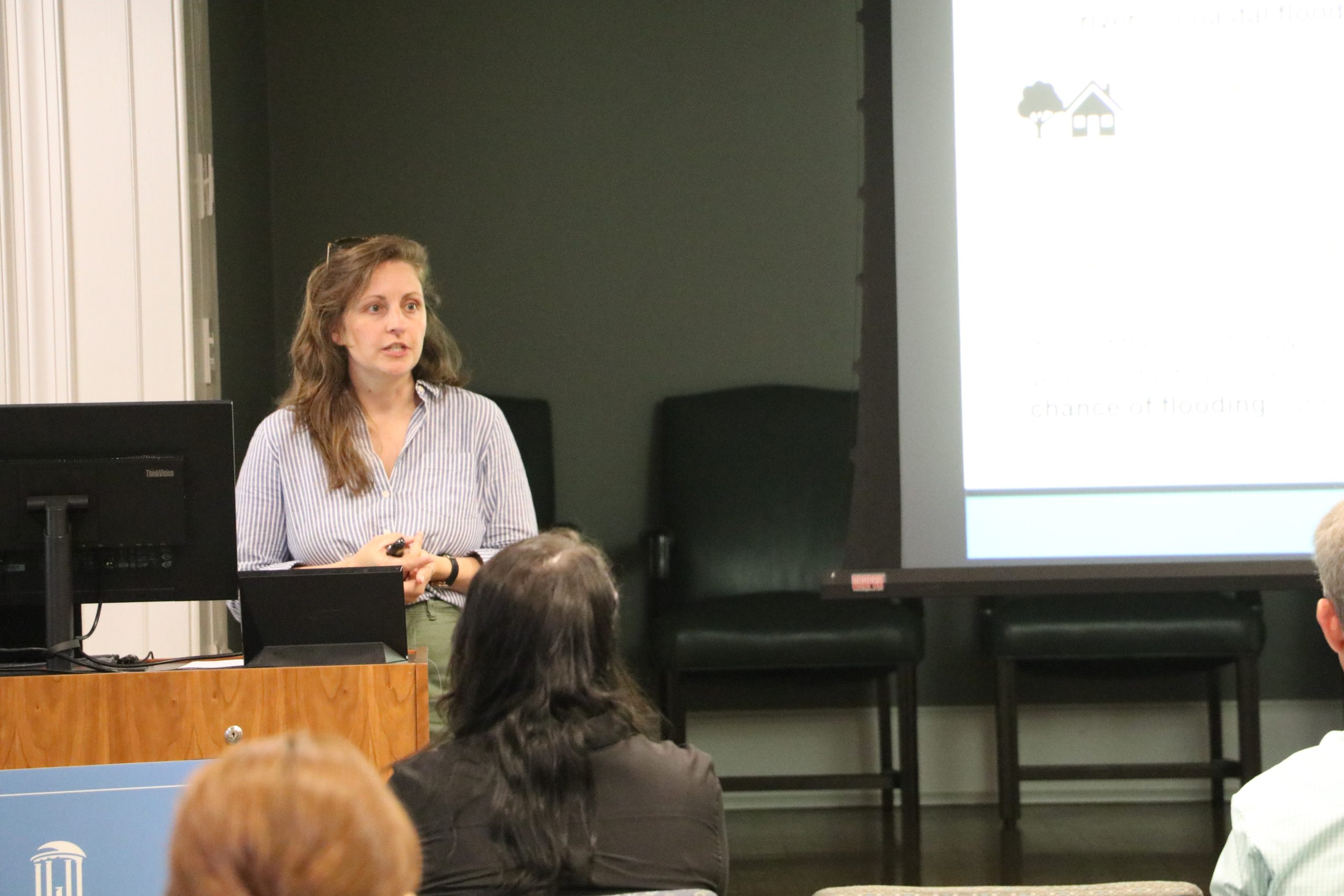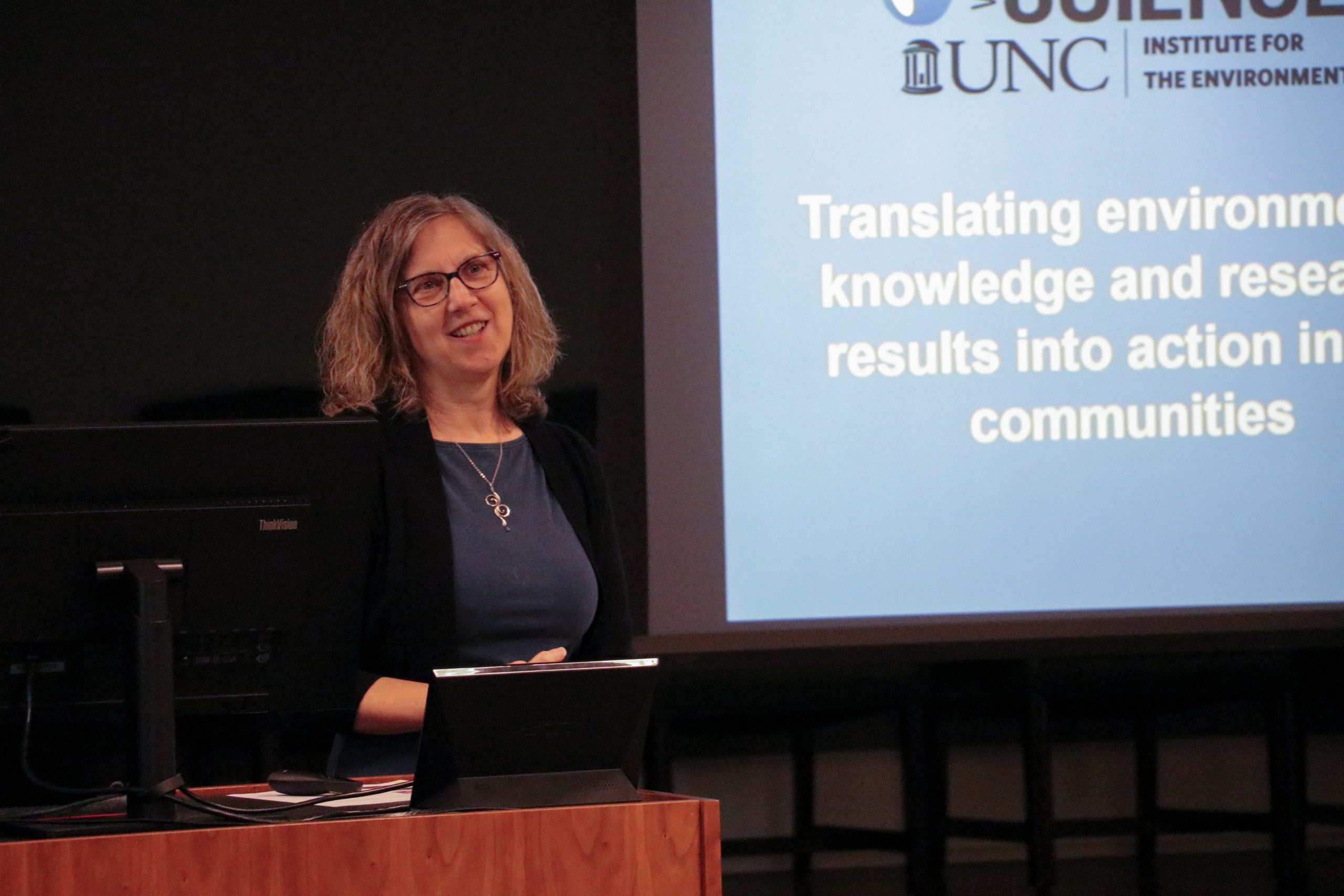Second annual research symposium highlights sustainability research across Carolina
April 29, 2024
Researchers, students, staff and community members gathered for the second annual Sustainability Research Symposium sponsored by Sustainable Carolina and the UNC Institute for the Environment on Apr. 16. at UNC’s Wilson Library. Researchers led lightning talks covering a range of topics showcasing the ground-breaking sustainability research that happens across UNC-Chapel Hill.
“When we began Sustainable Carolina, which is our sustainability initiative at the University, one of our goals was to intentionally couple our sustainability practice to the research enterprise of the University,” said Mike Piehler, chief sustainability officer and director of both Sustainable Carolina and the UNC Institute for the Environment. “There are lots of important things going on at the University, obviously, many of which have application in the sustainability realm.”
Carolina’s blue carbon
Piehler kicked off the program, covering how Carolina is using blue carbon to offset its carbon footprint, while at the same time using the opportunity for research. Blue carbon refers to the natural process where ocean and coastal habitats absorb and store carbon dioxide from the atmosphere.
Piehler outlined his partnership with project lead Antonio Rodriguez and Joel Fodrie both professors in the Earth, Marine and Environmental Sciences department, to create a blue carbon habitat at the Institute for Marine Sciences in 2014. The habitat was designed to capture carbon and store it in the ocean and sand using pilot funding from UNC’s Energy Services. The team constructed a salt marsh habitat using 3,500 bushels of oyster shells and 2,000 bundles of marsh grass (See timelapse). The team has used the habitat over the last decade to track carbon storage over time and help UNC reach its carbon neutrality goal by 2040.
“The exciting news is we have now have a carbon inventory to understand what’s here.” Piehler said of the project. “We’re in a great spot to know what we’ve done that is good so far and to understand what else we can do to advance carbon sequestration, shoreline stabilization and its use as a research asset all in the same place.”
Healthier, sustainable and more equitable diets
Lindsey Smith Taillie, an associate professor in the Gillings School of Global Public Health’s Department of Nutrition, presented her research on designing and evaluating food policies to support healthier, more sustainable and equitable diets across the globe.
“How do we grow a planet that is still growing population-wise a diet that is both healthy and sustainable?” Taillie asked. “Clearly we can’t have a food system that feeds people a healthy diet if we don’t have a food system that is also sustainable.”
In a snapshot of the type of work she does, Taille explained that environmental sustainability has carved out a place in the public health literature over the last five years. In her work, she has seen that poor diets equate to poor health and low- and middle-income countries grapple with this along with bearing the brunt of climate-related impacts.
“Diet impacts climate and vice versa,” she said.
Taille has conducted experiments to test policy options like adding taxes or warning labels to food to change a population’s behavior. She also works on issues like preventing food waste and food insecurity by designing interventions to prevent food waste and improve nutrition.
Flood evacuation notices and adaptation
Abhishek (Abhi) Bhatia, a doctoral candidate in the Carolina Health Informatics Program talked about his research that combines large-scale clinical, demographic and geospatial data to estimate the effects of climate hazards on population displacement and health.
“Climate disasters are increasing in frequency and intensity worldwide,” he said.
Two of his recent studies followed disasters in Puerto Rico and India where his lab analyzed responses using collected data from local governments and communities.
“As a key takeaway, I want to note that the consequences of climate change are indiscriminate,” he said.
He emphasized the importance of post-disaster assessments on long-term adaptation. He also highlighted the need for good data to yield timely research and collaboration and community-based action to achieve long-term solutions.
Using satellites to track the world’s water
“So we just heard some really down-to-earth, practical research. I’m going to instead talk about research that we do from space,” quipped Tamlin Pavelsky, a professor in UNC’s Department of Earth, Marine and Environmental Sciences who spoke about his work with NASA’s Surface Water and Ocean Topography (SWOT) mission. “I call it a new eye in the sky for Earth’s water.”
Pavelsky recalled attending one of the first meetings for what would become the SWOT mission. Eighteen years later in 2022, he was at the launch of the satellite in California. SWOT is a NASA satellite designed to measure water levels on Earth’s surface using radar technology. Researchers hope to use the data it collects to study things like ocean circulation and how heat and carbon get transported in the ocean. Pavelsky, a freshwater researcher, will use it to study where and how deep the water is.
“Essentially for rivers, for lakes, for reservoirs, SWOT can track basically how water levels are going up and down. If you think about water resources, if you think about flooding, that is information we really want to know,” Pavelsky said.
Mapping climate risks
Antonia Sebastian, an assistant professor with joint appointments in the UNC Department of Earth, Marine and Environmental Sciences and the Environment, Ecology and Energy Program, studies the application of interdisciplinary methods in socio-hydrology and engineering, evaluating how flood risks evolve in response to changing human and environmental conditions.
“It’s important to point out in the last couple of years, global flood losses were estimated to be about $300 billion over a 4-5 year period,” she said. “But they are predicted to reach about $1 trillion annually by 2050. This is a function of the changing hazards, but also largely a function of where we are placing people.”
The goal of Sebastian’s lab is to advance the understanding of the dynamic interactions between people and the environment and how they are changing over time. Sebastian pointed to two current projects out of her lab examining how flood risk has changed in the recent past, since 1900, and how it might change in the near future.
Her team uses an array of models using physics, statistics and machine learning to model past events and predict future ones.
Stormwater Management
At the UNC Environmental Finance Center, Project Director Anna Patterson, focuses on improving environmental health within communities and helping water utilities achieve financial resilience.
“We work with a lot of local governments predominately with water waste and stormwater utilities to increase financial sustainability and resiliency. We work a lot in the field of affordability and equity, we do benchmarking and innovative funding solutions,” she said. “We try to work with these utilities and figure out how to pay for it.”
There are a host of ways to pay for stormwater management, she explained, such as tax dollars or stormwater fees collected through tax or utility bills.
“We love to work in stormwater finance because we help our local governments improve their resiliency for their environmental services.
The EFC offers a stormwater utility fee dashboard to for communities to compare rates across the state.
Microplastics at the Highlands Field Site
Chloe Hall, a senior studying environmental science, and the inaugural recipient of Sustainable Carolina’s Excellence in Sustainability Research Prize in 2023, shared her research on microplastics in freshwater systems.
Hall was introduced to this research while a student at UNC’s Highlands Field Site. In 2018, when the research project got its start, less than 4% of studies on microplastics focused on freshwater systems.
“This was a pretty staggering fact for my [principal investigator] and my team and led them to start this project and attempt to begin building up freshwater microplastic sampling methods in the Southeast region,” she said.
The study ultimately found microplastic contamination in the Chattooga River, which is a biodiversity hotspot in the Southern Appalachians. Microplastics cause a host of problems that researchers are still trying to understand and this situation should be monitored closely, Hall added.
Student engagement opportunities
Kathleen Gray, research associate professor and director of the UNC Institute for the Environment’s Center for Public Engagement with Science (CPES), shared ways students, faculty and staff can participate in research at Carolina.
“We engage students, faculty and staff in the work we do to really connect people in North Carolina with the environmental science of UNC-Chapel Hill,” Gray said.
Gray outlined an example of a collaboration with Pavelsky, where her team helped launch a citizen science program for the SWOT mission, where anyone who walks by a lake gauge can participate in validating the lake height data coming from the satellite by simply taking a photo and texting it through an app.
Her team also co-designs projects to respond to needs in the state, such as groundwater contamination or communities that have concerns about the quality of their drinking water from private wells. They help environmental and health agencies in communicating risk, like fish consumption advisories. They also introduce young people to climate science and work with public school teachers, introducing them to the latest research coming out of Carolina. Her team also facilitates environmental health undergraduate research experiences.
Students who have partnered with CPES have had opportunities to present at national meetings and contribute to research publications, Gray explained.
“We welcome students and staff and faculty to partner with us. We are helping students gain new skills, build their professional networks and importantly have fun and find joy in this work that can sometimes feel hard when we are really addressing some of the biggest issues facing us today.”
Watch full playlist of presentations on our YouTube Channel.
See the photo gallery on Flickr.








